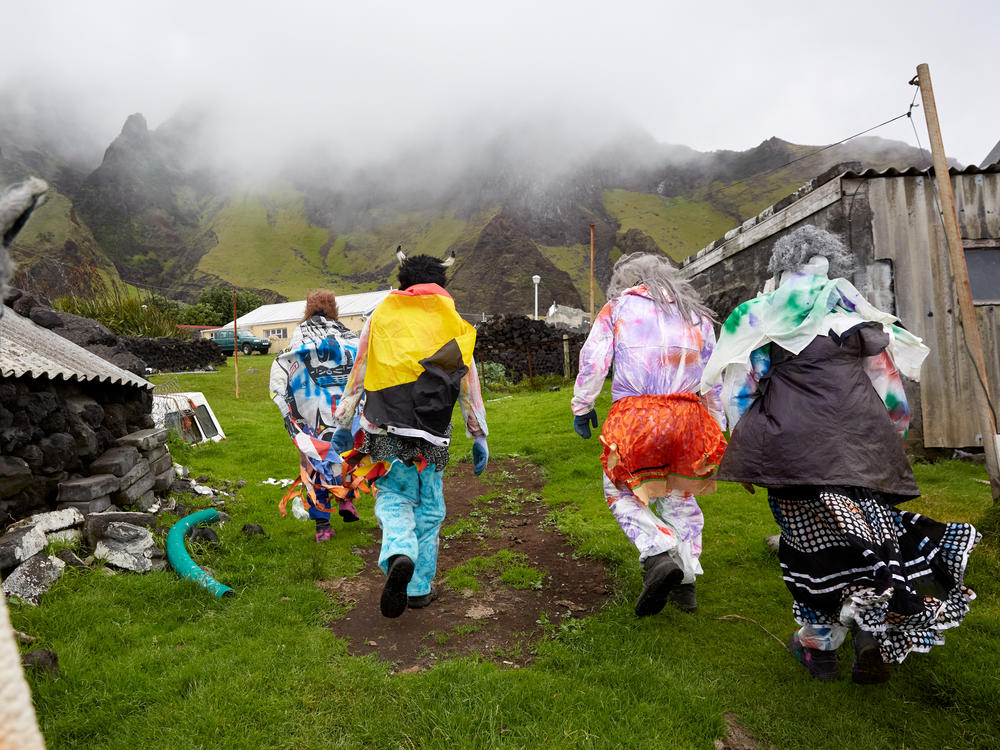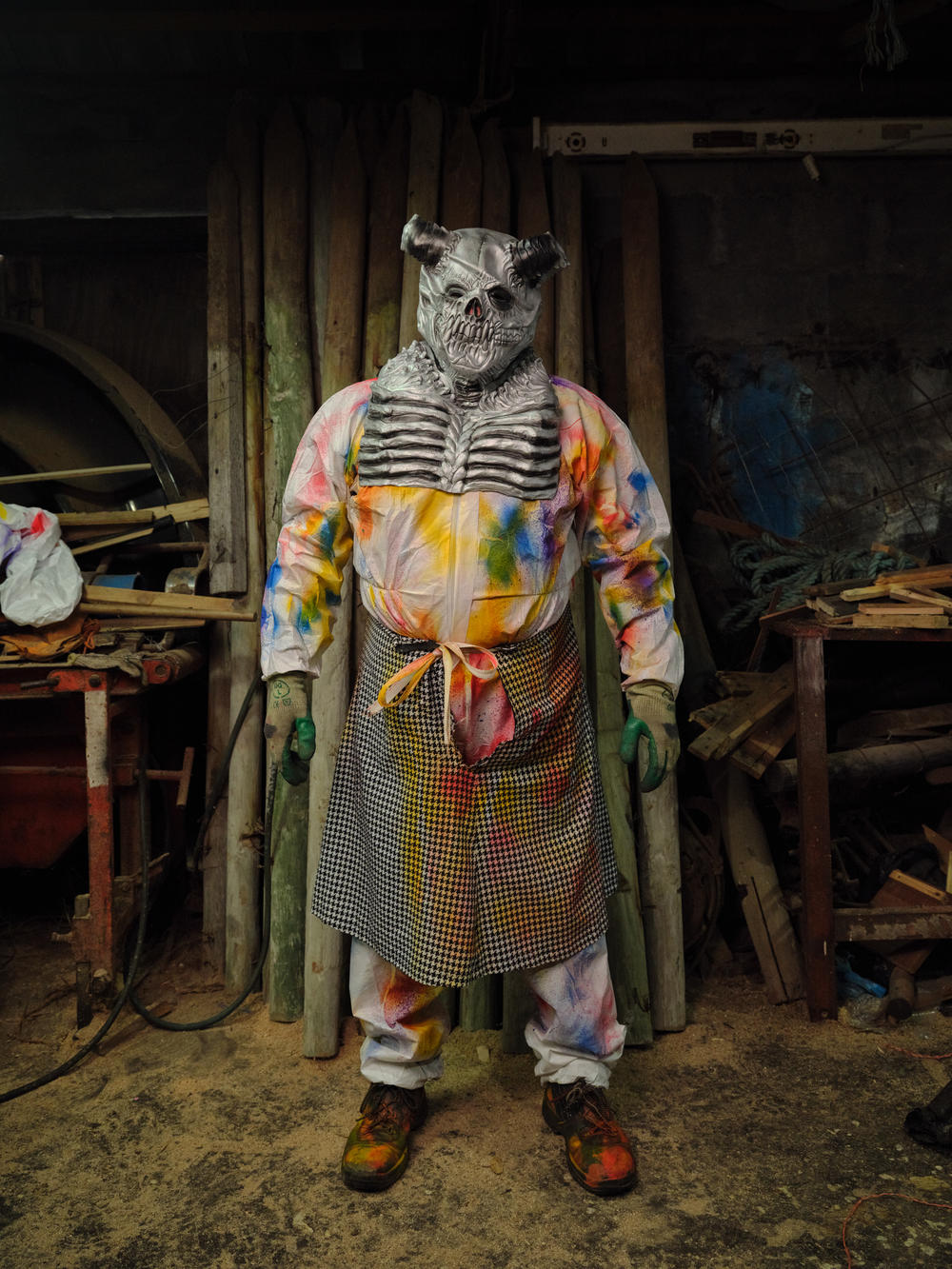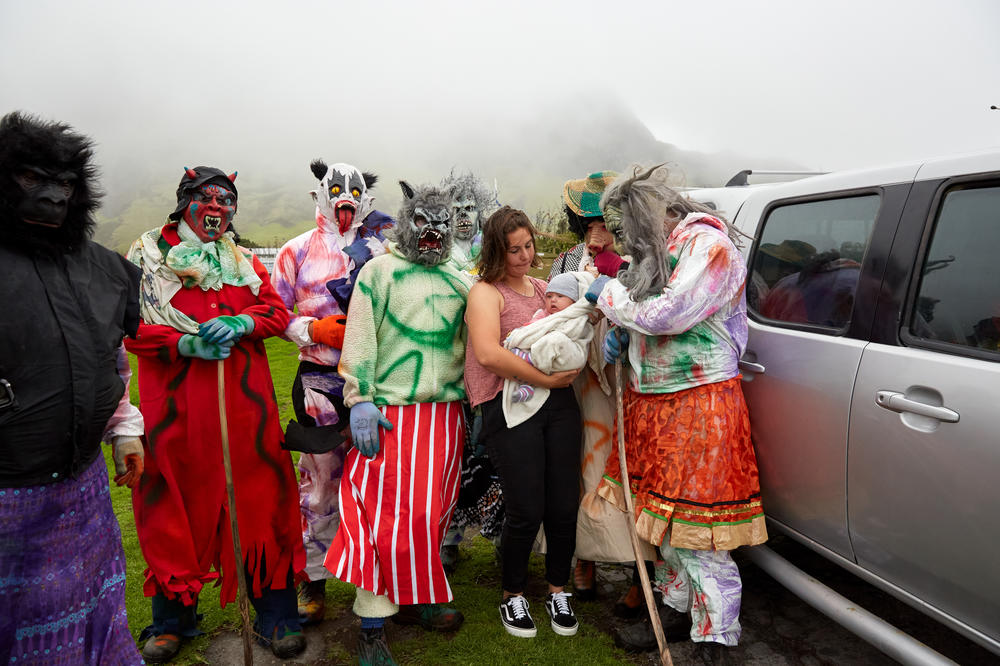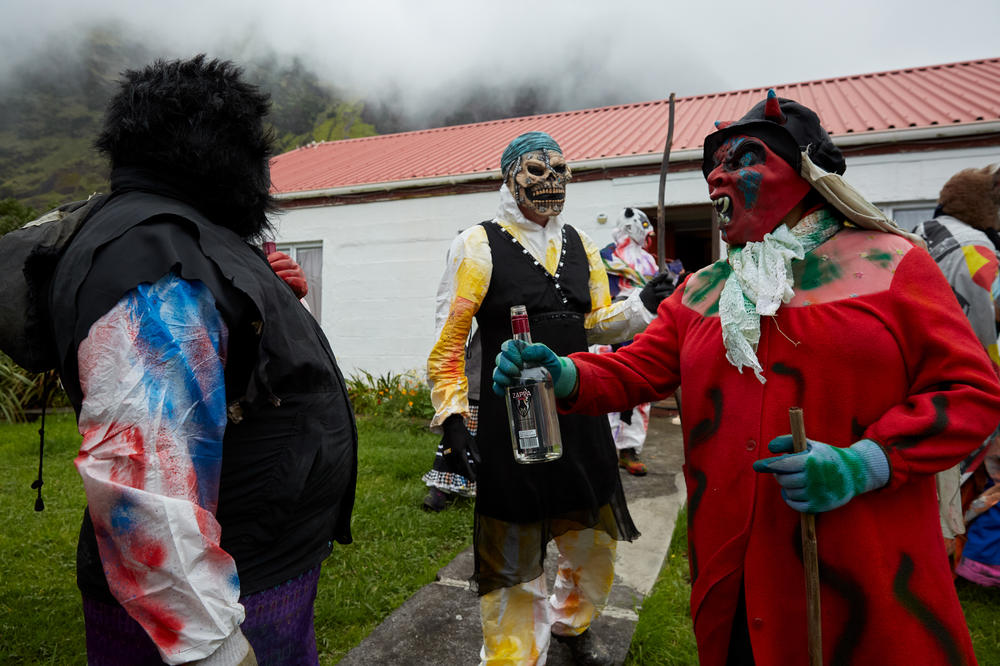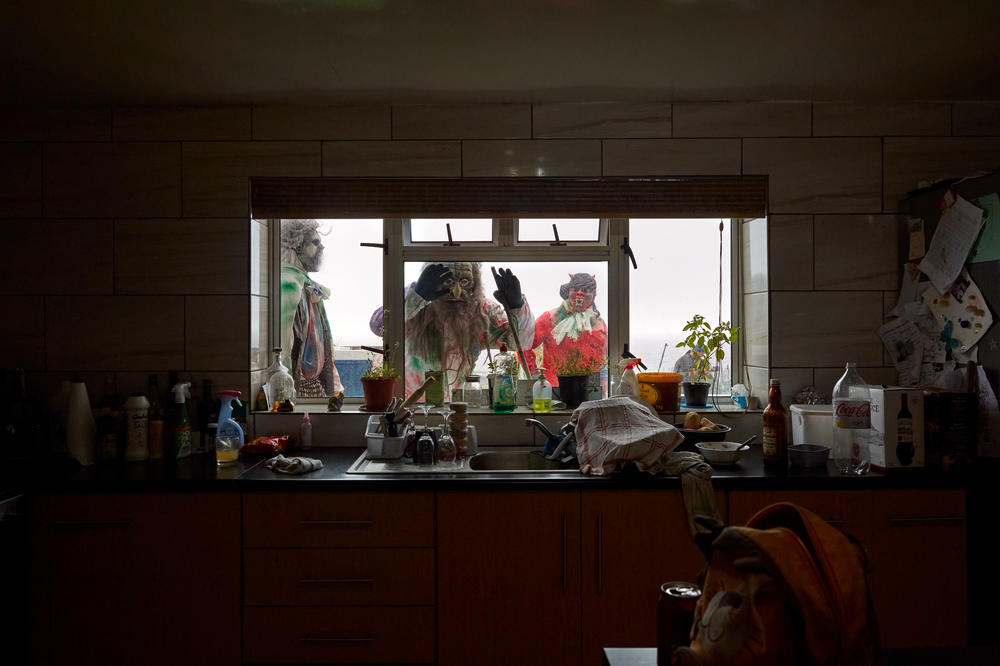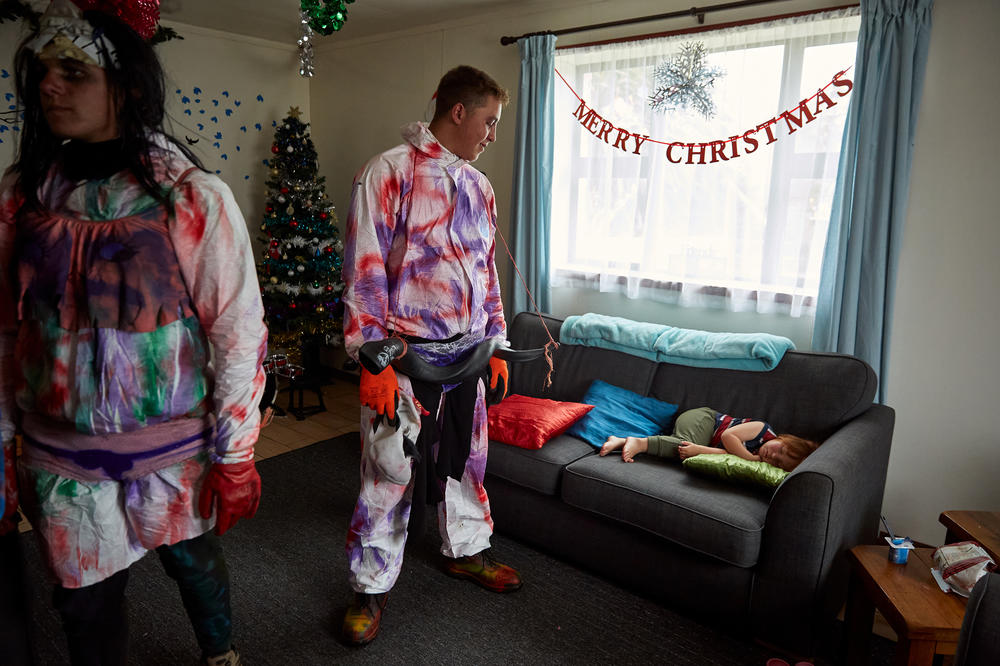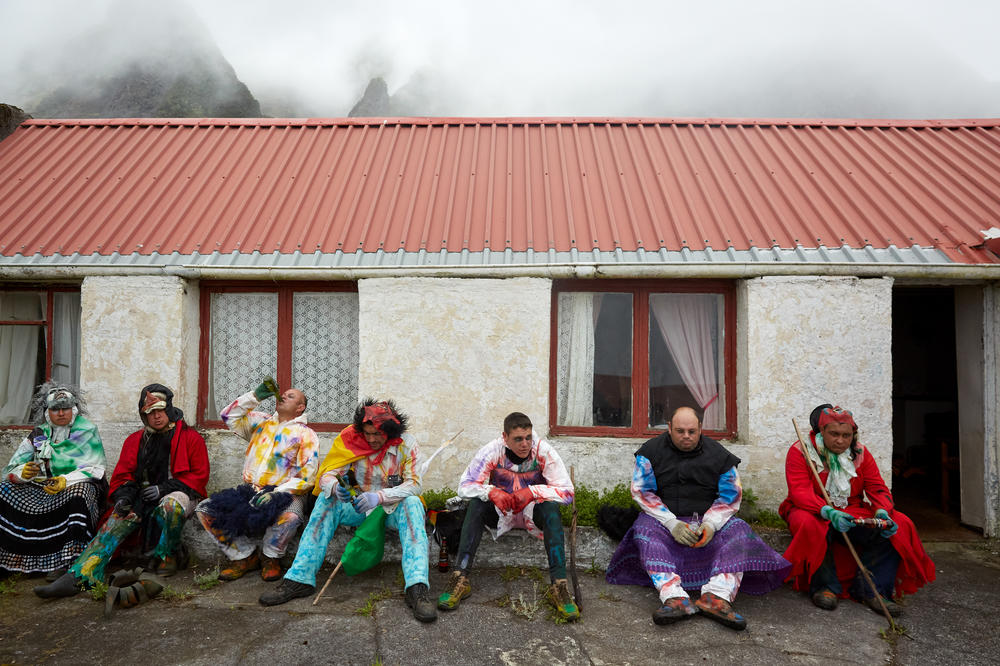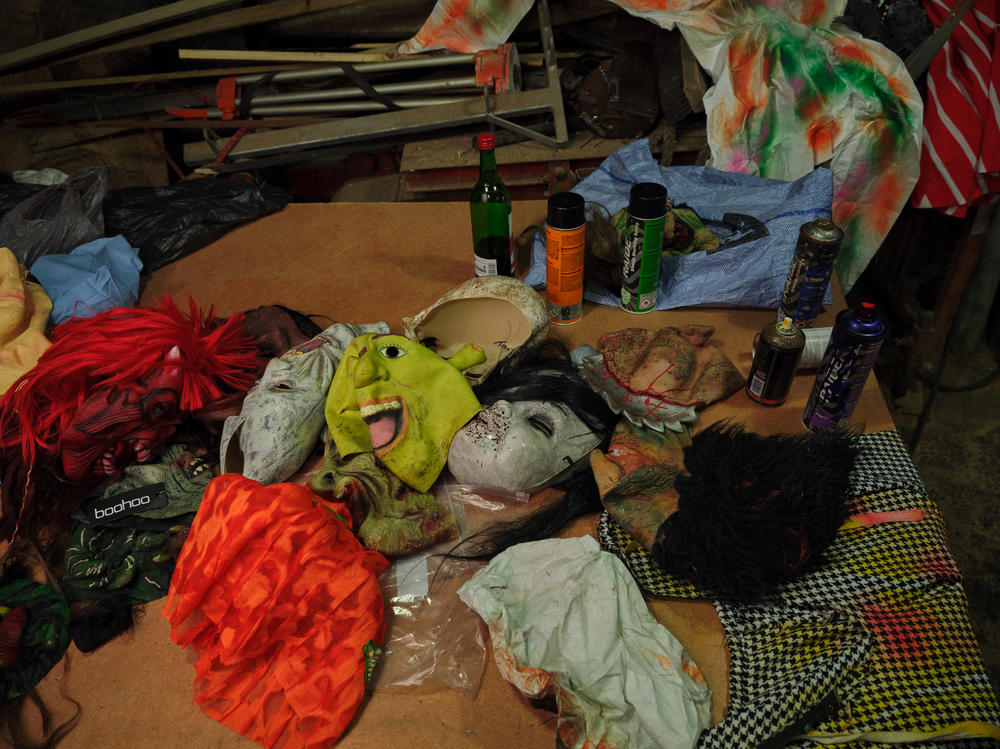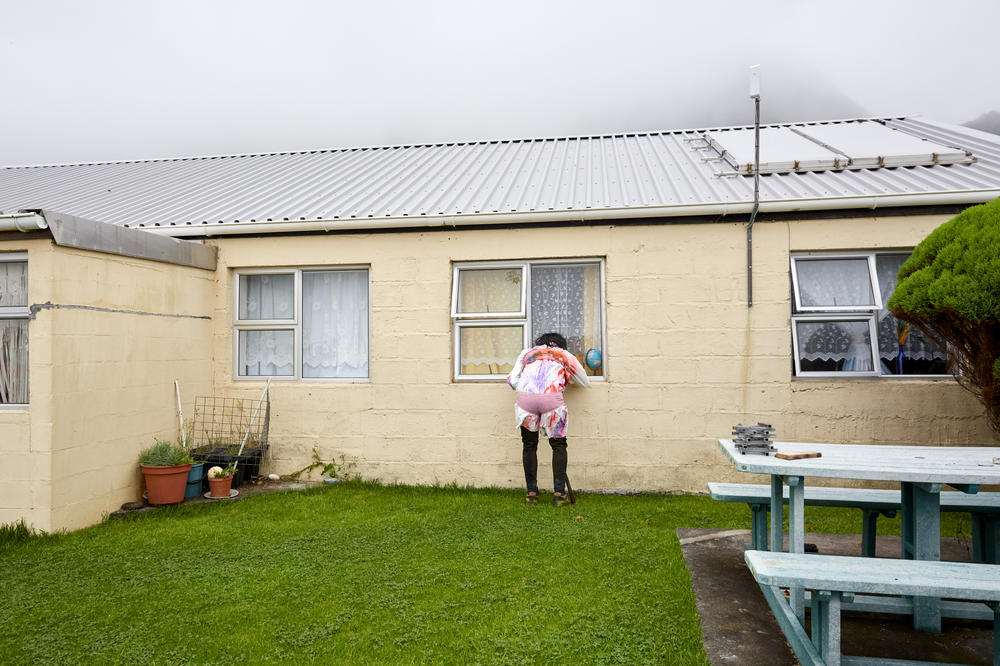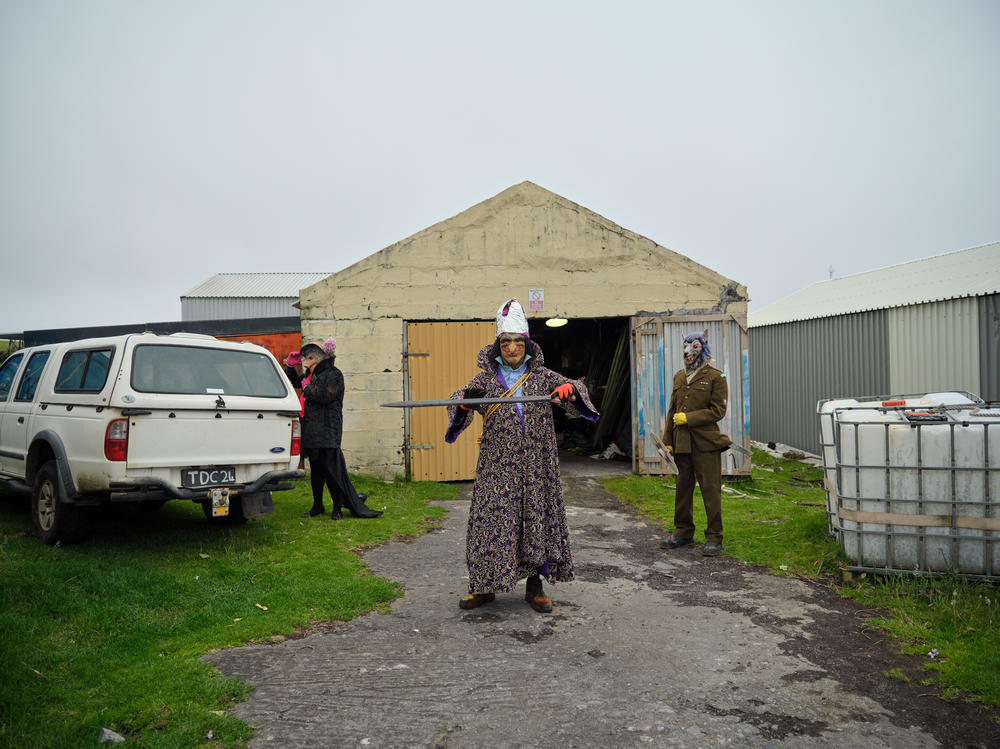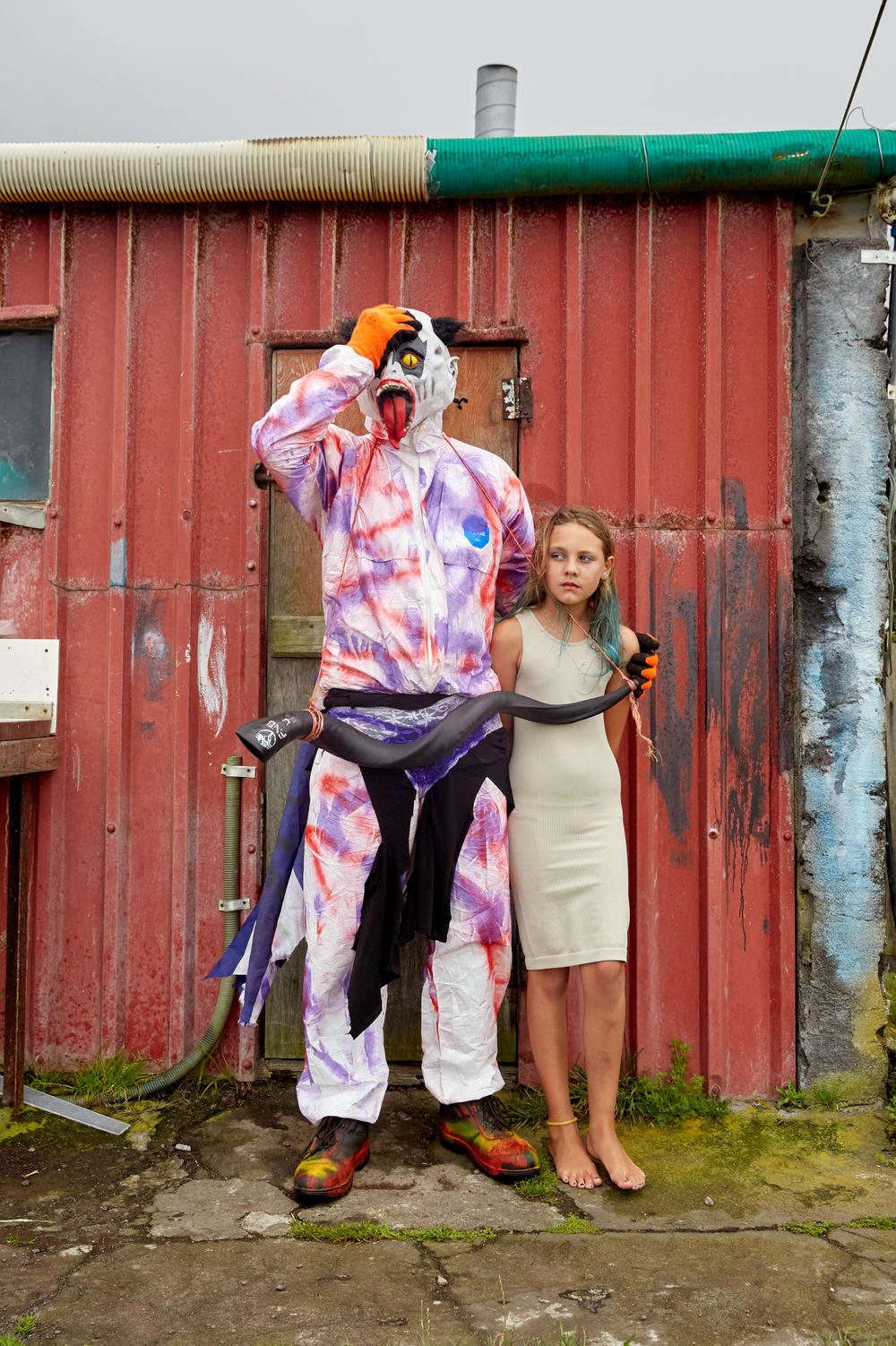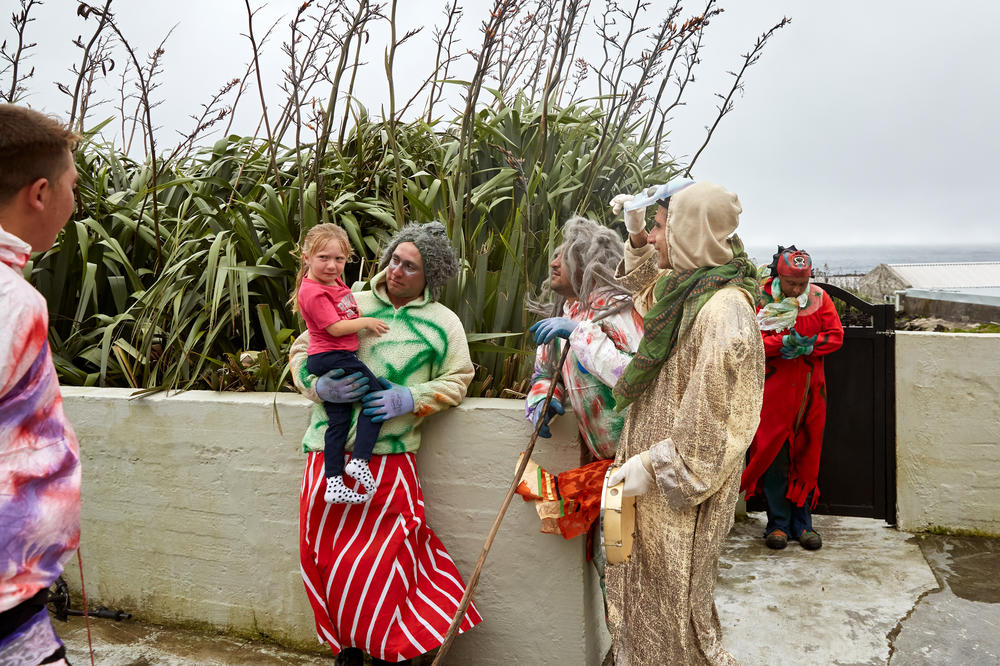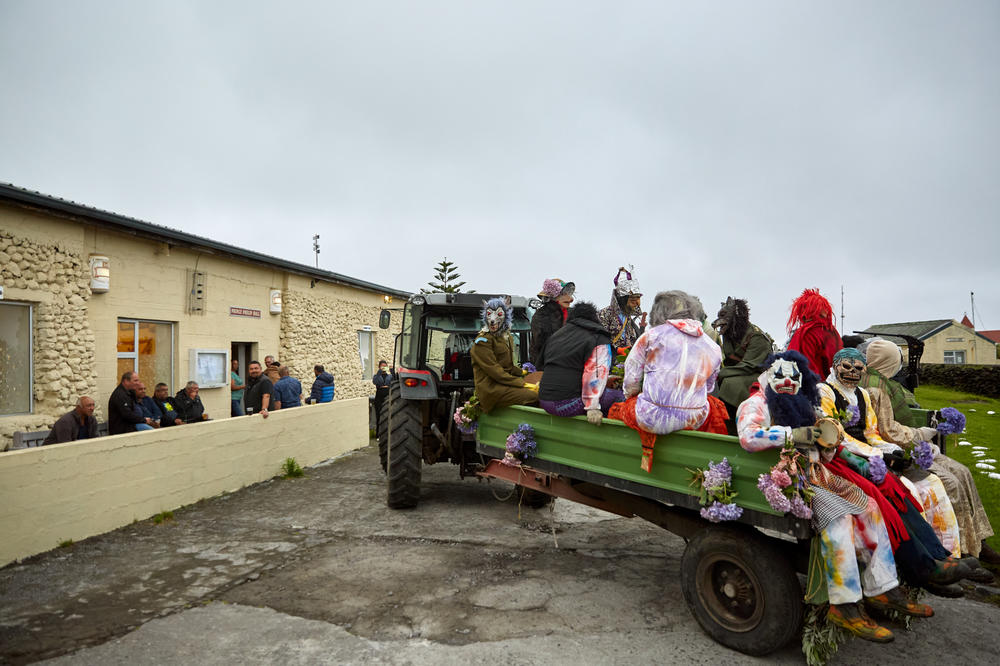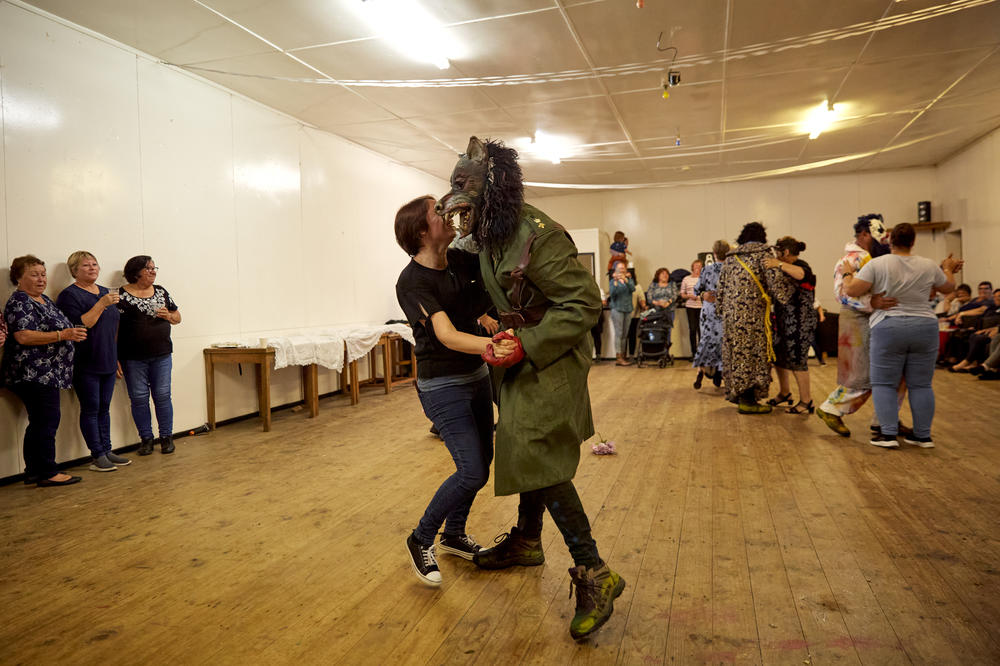Section Branding
Header Content
The Okalolies of Old Year's Night: Celebrating tradition on the world's most remote inhabited island
Primary Content
Dec. 31, 2023, shortly before 2 p.m. Gray, low-hanging clouds obscure the tops of green cliffs that tower over Edinburgh of the Seven Seas, a village of 238 people and the sole settlement on the island of Tristan da Cunha.
Tristan lies in the middle of the South Atlantic ocean, a famously wild and unpredictable expanse of water.
The closest inhabited place is St. Helena, the island where Napoleon Bonaparte lived out the last of his days that sits 1,514 miles to the north; around 2,434 miles to the west lies Montevideo, the capital of Uruguay; to the south, you'll find nothing but cold ocean and icebergs until you hit Antarctica; and 1,732 miles due east lies Cape Town, South Africa.
Buffeted by blustery South Atlantic gusts, I follow brothers Dean and Randal Repetto as they make their way through the deserted streets. We're the last to arrive at a small sawmill nestled in between two corrugated iron warehouses.
We walk into an impromptu, clandestine changing room, home of this year's Okalolies of Old Year's Night. Old skirts and masks and cans of spray paint that are ordinarily used by islanders to mark their sheep line both sides of the sawmill. The other participants are already getting dressed. The goal is to disguise oneself as fully as possible and to remain anonymous throughout the day.
On Tristan da Cunha, the Okalolies only come alive on Dec. 31, hours before the start of the new year. For 26-year-old Dean and 21-year-old Randal, who were both born on Tristan and have lived here their entire lives, Old Year's Night is an annual tradition they look forward to.
Photographer Julia Gunther and I asked if we could join the Okalolies for the day, which they agreed to.
An ecosystem of global significance
A single dormant volcano reaching 6,765 feet above sea level, Tristan da Cunha is part of a remote archipelago with the same name. Other than Tristan, the islands — Inaccessible, Nightingale, Middle and Stoltenhoff — are uninhabited, except for a South African manned weather station on Gough Island.
Two of the islands were awarded UNESCO World Heritage status for their outstanding natural beauty and universal value: Gough Island in 1995 and Inaccessible Island in 2004.
The waters around Tristan are some of the richest and pristine in the world, and the archipelago is home to the world's only breeding colonies of spectacled petrels and Atlantic yellow-nosed albatrosses, as well as 37 endemic species of plants and the world's largest population of sub-Antarctic fur seals.
In a testament to the significance of the archipelago's flora and fauna, the waters surrounding Tristan da Cunha were declared a marine protection zone in 2020 by the island's government along with the U.K. — the largest in the Atlantic Ocean.
An archipelago of islands difficult to reach
The first thing most people will tell you about traveling to Tristan Da Cunha is just how hard it is to get there. For many, though, that's part of the appeal.
Depending on the weather, the trip from Cape Town can take seven days across flat, calm water, or up to two weeks rolling and pitching in the strong westerly winds that blow sailing ships from Europe to the East Indies or Australasia.
Most will have traveled from Cape Town on the MFV Edinburgh or MFV Lance — two lobster fishing vessels that offer the only regular connection to Tristan. A third far larger ship, the Agulhas II, makes the trip once a year.
A lucky few will have arrived here on one of the cruise ships that regularly cross the South Atlantic as part of their annual relocation from the Northern to Southern hemispheres.
Our own trip was a good example of the uncertainties islanders and visitors face to reach the island. After spending a month in Cape Town waiting for space on one of the regular ships, we decided to risk hitching a ride on an expedition cruise ship, the SH Diana.
After five days at sea, we arrived at Tristan to find the only harbor closed due to heavy swells. Luckily, the Edinburgh was fishing nearby and we were able to transfer to her to wait out the weather. After another five days, the seas were calm enough for us to land. Had the Edinburgh not been where she was, we would have ended up at the cruise ship's final destination, in Ushuaia, Argentina.
Other than day tourists from visiting yachts or cruise ships — the latter of which can momentarily double or even triple Tristan's population — and a busy few weeks at the end of August when the largest regular ship of the year, the SA Agulhas II, drops off new expats, returning islanders and a few tourists, the island sees very few visitors.
On Tristan da Cunha, a night for making 'mischief'
You'd be forgiven for thinking that it's impossible for a group of 15 young men to keep anything a secret in a community this small, but that is exactly what we — 16 Okalolies in total — manage to pull off.
Okalolies are always male. There is no selection process. "You just need to be brave enough," explains Randal, who himself was 15 years old when he first took part.
Young boys see the tradition as a rite of passage. Randal remembers putting on an Okalolies mask as a child. "I looked into the mirror and frightened myself to death," he laughs as we get into our costumes. Now, he can't wait to find others to scare.
One of the first years that Albert Green, 67, was an Okalolie, he and a friend were getting dressed in his father's shed. "We had our backs to one another and when we turned 'round, we both jumped with fright," Albert says.
At 94, Gladys Lavarello is one of the oldest Tristanians on the island. She remembers a young woman called Liza, who, during one Old Year's Night back in the 1970s, dressed up as an Okalolie and managed to fool all the men into thinking she was one of them. "She was dancing around with them and they didn't even know it was her," Gladys recalls with a smile.
Like his older brother, Randal is a seasoned Okalolie. Now, it's their job to show Tristan Glass, 16, Kieran Glass, 18, and Calvin Green, 15, how it's done. "The young guys learn by watching us older ones. They just follow us and pick it up as they go on," Dean explains.
Although the village fully expects them to appear and cause havoc — as they have for at least a hundred years — exactly who will be an Okalolie and where they will get dressed remains a closely guarded secret.
"We don't want to let people know where we'll be coming from, as it makes it scarier," Randal explains.
Randal knows the look he's going for. "Anything that looks ragged and scary, especially zombie-like," he tells me as we walk through the sawmill.
Dean has been an Okalolie for the last 13 years, but he still gets excited. "I feel really energetic," he says. "I'm ready to look scary and roam the village, knocking on doors and frightening people."
Some Okalolies, like Randal, Dean and 36-year-old Shane Green, planned their looks days before and have brought their own masks or dresses — Shane has worn the same costume for the past 10 years.
Others, including me, design their outfits on the spot, picking from an extensive collection of masks ordered from the U.K. and South Africa by a community development fund — which helps pay for and promote island traditions — as well as old skirts and coats and bits of worn workwear.
I choose a white disposable coverall — which I am encouraged to "personalize" with green and orange spray paint — and a black and red cape. For a mask, I pick out an alien-type thing.
I'm told that Okalolies don't speak, as this would give away our identities. The silence also adds to our eeriness — a masked group of young men, marauding through the village, looking for "mischief."
As we head out onto the empty streets of Edinburgh of the Seven Seas, a few last islanders hurry past.
We communicate through hand signals, whistles and whispers, but we can make noise by banging on windows and doors, blowing on horns and playing whatever instrument is at hand — this year, it was a toy accordion and a child's tambourine.
We decide as a group which houses to visit. Some have made arrangements with the residents, who allow us to frighten their children or invite us in for a beer or cider.
A rich and eclectic history
Despite being discovered in 1506 by Portuguese Admiral Tristaõ da Cunha, who named the main island after himself, Tristan da Cunha wouldn't be permanently inhabited for another 300 years.
In 1810, Jonathan Lambert, from Salem, Mass., claimed the archipelago as his own and renamed them the "Islands of Refreshment" in hopes of attracting passing ships in need of fresh water and supplies.
Six years later, in 1816, Tristan da Cunha was annexed by the British, who were worried the French would use the island as a staging post for freeing Napoleon from his imprisonment on St. Helena.
Another major concern was the possibility of American occupation. During the War of 1812, Tristan had served as a base point for American ships to disrupt British maritime activities. Interestingly, the final naval engagement of that war was fought near Tristan in 1815, just a year before the British arrived.
When the British garrison departed a year later, three men, led by Corporal William Glass, opted to stay behind. They embarked on an extraordinary venture dubbed "the firm," grounded in a formal agreement for communal living.
This document, now kept at the British Library, entailed equal distribution of shares and provisions, equal division of profits, shared responsibility in covering expenses, and a commitment to equality without any individual islander holding superiority over another.
Although now a part of the British Overseas Territories, much of the independent spirit captured in Glass's document is still present on the island today.
A tradition of uncertain origins
The Okalolies are part of a type of visiting custom known as mumming or guising, in which young men disguise themselves, visit homes and engage in playful pranks — mainly on Christmas and New Year's — that have existed in Europe for the past 500 years.
Although she can't remember how or why the Okalolies got their start on her island, 94-year-old Gladys Lavarello knows they existed when she was a little girl. "The men would dress up and come 'round, singing and dancing. Then they'd take their masks off," she tells me in her living room, a few weeks later.
"My father would go 'round with a wheelbarrow and a pitchfork and say that he was cleaning up the mess," she adds with a laugh.
There is no academic consensus on the origins of the name for the tradition here. It could be derived from the Afrikaans words "Olie Kolonies," meaning "old ugly men" — Cape Town, South Africa, has long been the main port of call for ships traveling to Tristan.
According to Peter Millington, a retired research fellow at the University of Sheffield who has studied house-visiting customs around the world and who took part in the Okalolies tradition in 2019, the Okalolies are likely "an amalgam of the customs of the home countries of the original settlers, including families no longer present on the island."
"The name might have been introduced by transient expat residents, or it might simply have been made up on the island," Millington offers.
New Year's Eve used to be called Old Year's Night in much of Scotland. Corporal William Glass, one of the three British soldiers who elected to stay on Tristan after the garrison departed in 1817, hailed from Kelso, Scotland, where "Auld Year's Nicht" was still being celebrated in 1923.
Old Year's Night is also a direct translation from the Dutch Oudejaarsavond. Peter Green, formerly Pieter Groen, from the Netherlands town of Katwijk, was another early settler who remained on the island after his ship, the Emily, wrecked on the coast in October 1836.
The oldest known account referring to the Okalolies tradition on Tristan da Cunha — albeit not by name — is detailed in K.M. Barrow's book, Three Years In Tristan Da Cunha, and dates back to 1907.
For Tristanians, a tradition that's expected and — for some — still feared
As with most long-lived cultural practices, the Okalolies' tradition has changed over time. When Gladys was a child, it was predominantly about celebrating the end of the year.
"They used to fire guns to announce they was coming 'round," Gladys remembers. "We didn't have much in those days, but we'd always make sure there was milk for them, and if we had a little flour, we'd make them a cake."
Initially, participants didn't wear masks but would paint their faces, and the tradition supposedly was teetotal, whereas more recently, alcohol is consumed throughout the day.
"The whole island would dress up," Albert Green recalls. "We'd go to every house and wouldn't finish till the next morning."
Over time, the Okalolies have gotten smaller in number, more mischievous, their outfits more frightening, and the day itself more focussed on scaring people rather than visiting homes.
More recently, homemade masks were incorporated, and nowadays, many wear shop-bought latex horror products.
Although all Tristanians are intimately familiar with the Okalolies, some remain genuinely afraid and hide inside their homes when they know they'll be out on the streets.
On this Old Year's Night, we roam together as a group for a few hours, during which we stop for breaks at friendly houses to cool off. Luckily, the weather was unseasonably cold for summer in the Southern Hemisphere — walking up the settlement's steep roads makes wearing latex masks and multiple layers of tweed and plastic outfits a hot and stuffy experience.
Then, silently and suddenly, we split up, with smaller bands roaming between houses searching for "victims," almost exclusively women or girls.
Tristanian women try to outsmart us by hiding in groups behind locked doors. Where no "victims" can be found, we enter the homes of families who have left their doors open.
Chantelle Repetto, 18, tells me she's been afraid of the Okalolies for as long as she can remember. "Being scared is normal — we don't know what the boys will do," she explains.
Rachel Green, 25, is not as frightened as she used to be, but she'll still run away when she sees them. "They used to throw people in the pool or in the flax," she says with a laugh, referring to the now-invasive plant first introduced to the island in the 19th century that's used to provide thatching materials for roofs. "But now they really only wet you with a hose."
Although some villagers are genuinely afraid of being caught, the Okalolies tradition is all in good fun.
"During Old Year's Night, the whole community comes together," explains Chief Islander James Glass — a Tristanian elected by the people of Tristan every three years who represents their interests alongside the Island Council.
"As we've become more Westernised; we've lost much of our culture," Glass continues. "The Okalolies are an established tradition that we want to maintain."
We're careful not to frighten children and older adults too much, and briefly remove our masks to calm scared children. In a community this small, chances are high that one of the Okalolies will confront their own son or daughter.
After two hours of knocking on windows and spraying water, I join Randal and Tristan as they rush back to the sawmill and quickly change into a new set of outfits. In honor of King Charles III's coronation, Tristan transforms himself into a king, and Randal into his queen.
Together with a "royal guard," King Tristan, Queen Randal and I climb onto the trailer of a waiting decorated tractor.
First, our procession heads to the residence of Administrator Philip Kendall — the U.K. representative on the island — to collect his wife, Louise. Then we move on to James Glass' house — to pick up his wife, Felicity.
Our passengers safely seated on two armchairs in the trailer, we escort our guests to Prince Philip Hall, the building that houses the village hall and the only pub on the island. There, the waiting administrator and chief islander, along with the entire village, wait to welcome us.
It is only now that we finally reveal ourselves. Then, it's time for dancing, barbecues — or braais, as they're known on Tristan — and, at midnight, the ringing of the fishing gong, an old gas bottle suspended from a rope and hit with a hammer or metal bar.
Although Randal, Dean and the other Okalolies don't yet know where they'll meet to get dressed for next year's Old Year's Night, they'll do their best to keep it a secret. Above all, Dean, like Chief Islander James Glass, is keen to carry on the tradition passed down by his ancestors.
"We frighten the old year out and bring the new year in."
Nick Schonfeld divides his time between writing children's books and working on stories about affordable health care, gender equality, education and distributive justice.
See more of Julia Gunther's work on her website or follow her on Instagram: @juliagunther_photography.
Catie Dull photo edited and Zach Thompson copy edited this story.
